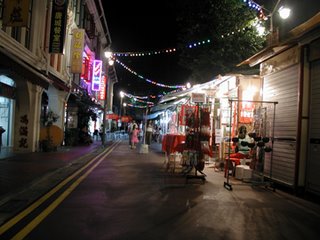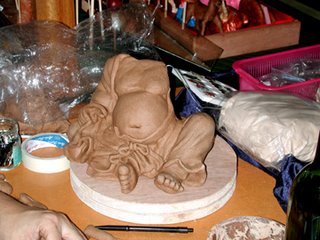 Sago Street today is a shade of what it was in the yesteryears. Only the remaining pre-war houses (as we call the shophouses) would know what happened over the years. Last Saturday night, I decided to look for some food in Chinatown and we walked and walked. We just couldn't find something that excites us.
Sago Street today is a shade of what it was in the yesteryears. Only the remaining pre-war houses (as we call the shophouses) would know what happened over the years. Last Saturday night, I decided to look for some food in Chinatown and we walked and walked. We just couldn't find something that excites us.My wife was reminiscing about the Trengganu St scene to my 12 year-old daughter. Yes, in the dating years, we used to smuggle out of her mother's watchful eyes to go to this yau-yi-ong-choy (re-processed dried cuttlefish with kangkong) stall that had kindergarten-size tables and chairs. There, for 50 cents we would enjoy a plate of dried cuttlefish or jellyfish with kangkong covered with red sauce and chilli, cooked to perfection by this old lady who probably was a perfectionist. Under her strict supervision were two women who helped to serve, whom until now we still could not figure out if one was the daughter and the other the daughter-in-law. She would scold them for a slight mistake .. and to us customers too if we reminded her one time too many. But, like kindergarten kids, we kept coming back. We could only relate.

We walked till the end of Sago St, which was at the junction of South Bridge Road. The population along the street got sparser as we walked towards the main road. The box-stalls stood neatly in a row. They were either shut or if open with the stallholder sitting looking bored. Behind these stall loomed the fast growing giant of a Buddhist Temple, which, hopefully in the near future would bring more life to Chinatown.
With hunger pangs, we decided just to sit on the last coffeeshop and ate what was available. It happened to be Hainanese Chicken Rice. It was a Saturday evening at 9pm, and the place was relatively quiet. Was it the World Cup (football?) Was it that the offerings were not attractive, to the locals nor the foreign tourists?

We decided to play tourist and peered into each box looking for something of interests. Indeed, there were many things of interests. But then, for a local, it might not be exciting enough for us to part with what we have in our wallet.
There was one that sold lights of all kinds. It gave a wonderful orangy glow .. that one could feel the warmth in a cold winter night. Alas, not in humid Singapore. Another was selling the typical local Chinese clogs - ones we wear in the old time kitchen, and these days, some may still use for the bath room. These do not look like those of the local market.

What caught our eyes was this stall with a guy happilying moulding a Laughing Buddha out of this wooden clay, looking at a picture of a Laughing Buddha for guidance. At S$5 a pack, it was reasonable enough for any parents to buy for their kids to play with. If they walk this way. Even though we were three, this guy stopped what he was doing and shared with us what he knew about the wooden clay. Ah, slowly but surely were sucked in, the interests in my art-inclined daughter growing. I went into the box to take a closer look at the finished products. Wow, models of the Chinese heritage could be seen, from Buddha to the Deities of the Hades to the Monkey Gods. When we decided to buy a pack just to try it out for fun, he got my daughter to learn how to make a hand with a quick 3-minute lesson to make sure that she would have the basic skills to do something when she gets home.
 For S$5, it was hard work, but he certainly got 5 very happy customers, who have already started the word-of-mouth campaign, and well, through blogging too. And of course, the curious passer-bys stopped to look. We left him to entertain a growing crowd.
For S$5, it was hard work, but he certainly got 5 very happy customers, who have already started the word-of-mouth campaign, and well, through blogging too. And of course, the curious passer-bys stopped to look. We left him to entertain a growing crowd.As we moved back into the heart of Chinatown, at the cross-roads of Sago St, Trengannu St and Smith St, there was this strange stall that seemed to be out of place but yet getting the best patronage! A crowd of Europeans were having a stammtisch there enjoying beer from the nearby coffeeshop (ah, Weiss Bier) and his different sausages, starting from Bratwurst. Most locals would tah-pau (takeaway). The chef has changed his Chinese cap with a Football cap. Yes, it is Football World Cup time.

And so, in each tiny part of the Chinatown, which could be considered as Kreta Ayer part or the greater one that covers right to Singapore River and Telok Ayer St, there is a story waiting to be told.
